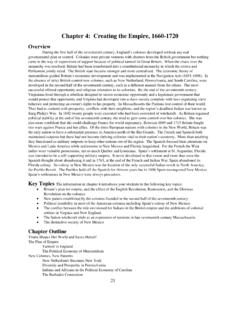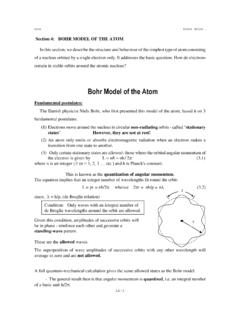Transcription of The Maxwell-Boltzmann Distribution - Pearson …
1 The Maxwell-Boltzmann DistributionGases are composed of atoms or molecules. These atoms or molecules do not reallyinteract with each other except through collisions. In many cases, we may think of a gasas a collection of tiny billiard balls flying through space, hitting one another again andagain. Even if we were to think that all atoms or molecules had the same speed to beginwith (although we do not), the constant collisions would result in a spread of manyspeeds. Some atoms could have very high speeds, others low ones. In real gases atequilibrium there is a Distribution of speeds (Fig. ). This Distribution is called theMaxwell- boltzmann Distribution , and it depends on temperature, as shown.
2 The hightemperature curve has proportionally many more fast molecules or atoms than the lowtemperature curves. As the temperature rises, the highest point on the curve is pushedout to higher v, and the maximum is pushed down toward the axis. All curves shown inFig. have a similarity in their The number of particles at speed v varies with the absolute temperature, as the shape of thecurve changes. However, the Distribution really has the same profile; the Distribution is pushed to the leftand upward as temperature decreases, and is pushed to the right and down as the temperature , Ch. 7, extension 4 The Maxwell-Boltzmann Distribution2It is also possible to show that the average kinetic energy of an atom or molecule,< 12 mv2 >, is directly proportional to the absolute temperature T.
3 For example, for a gasof individual atoms such as neon,< 12 mv2 > = 32 kT,where m is the atomic mass and k is a constant known as boltzmann s constant. Theaverage of the square of the speed increases with temperature, just as is seen in can actually experience the effects of the Maxwell-Boltzmann Distribution byperforming a few evaporation experiments. What is evaporation, and why does it requireenergy? Recall that the atoms or molecules of all materials are in constant of course differ. We are generally familiar with three states, or phases, ofmaterial: solid, liquid, and gas. To understand evaporation, we must look at thedifferences among the three solids, the molecules are cemented into their relative positions despite their incessantmotion.
4 There is a structure that is maintained. We are familiar with many solids that havecrystalline structure. The symmetry of the crystal reflects the symmetry of the bondsbetween the atoms or molecules composing the crystal. Most solids do not exhibit such aclearly ordered structure, but they are structured liquids, the interatomic or intermolecular forces attracting the atoms or molecules toeach other are weaker than those in solids. This allows the atoms or molecules to movesomewhat in relation to one another, while still keeping the liquid together. Thisweakened interatomic force is the reason that liquids can take on the shapes of theircontainers. The attractive force between liquid molecules is evidenced by the phenomenonof surface tension.
5 The beading of water, for example, is due to surface tension. Inside aEnergy, Ch. 7, extension 4 The Maxwell-Boltzmann Distribution3liquid, and away from the boundary, molecules are surrounded by other molecules of thesame type and are thus attracted in all directions equally. This is another way of sayingthat there is no net force at all on molecules inside the liquid; those molecules are inequilibrium. For the molecules on or very near the liquid surface, however, attractiveforces come only from inside the liquid to act on them. Thus, they are attracted back tothe liquid surface should they try to gases, such as water vapor, the molecules are essentially free to move wherever theyare going.
6 That is, the attractive forces are essentially negligible. There is no all these phases, molecules are dancing about in some way. In the solid, the moleculesvibrate in various ways about their fixed positions in the solid lattice. In liquids, thisdance of the molecules also occurs. Even in transparent liquids, we are not able to see themotion of the liquid molecules. In some liquids that contain very large molecules, the largemolecules can be kicked about randomly under the impact of the smaller, invisible liquidmolecules. If the molecules are large enough to be seen, we can then see the effect of therandom motion on the larger molecules. This visible motion is termed Brownian properties of materials at temperatures above absolute zero that is, those materialsexhibiting the molecular motion are described by distributions giving the relativenumbers of molecules at the different speeds of motion possible for the material.
7 TheMaxwell- boltzmann Distribution of Fig. a illustrates the properties of thedistribution of speeds in typical gases or liquids: there is a range of speeds of molecules,and there is a most probable speed at a given temperature. Thus, in any gas or liquid,there are many molecules going fast and many going slow. In fact, the Distribution showsEnergy, Ch. 7, extension 4 The Maxwell-Boltzmann Distribution4that we can measure the temperature by determining the average molecular speed (see b).Molecules approaching the boundary of a liquid generally are trapped back into the liquidby the surface tension. The very fast molecules may be able to penetrate the surfacebarrier and escape the liquid altogether.
8 The more surface available, of course, the fasterthe rate of escape. The rate also increases as the temperature increases because of theboosting of molecules to higher This illustrates what happens to a Distribution when almost all the faster particles aresuddenly removed. The effect is a cooling, since temperature is a measure of average thermal may distinguish two sorts of evaporation. In liquids with a relatively small surfacearea, the liquid absorbs heat from the surroundings to keep the temperature of the liquidfixed as the faster molecules escape. The absorbed heat speeds up some molecules,restoring the original Maxwell-Boltzmann Distribution . The total number of molecules inthe liquid decreases, but the Distribution which depends only on temperature remainsthe same.
9 In the second sort of evaporation, the surface area is relatively large. Thus, thefaster molecules leave the surface rapidly enough that the liquid cannot absorb enoughheat to restore the original Distribution . In this case of non-equilibrium evaporation, thedistribution quickly becomes truncated. (It looks as shown in Fig. ). Since theabsolute temperature measures the average kinetic energy of a gas, a departure of high-Energy, Ch. 7, extension 4 The Maxwell-Boltzmann Distribution5kinetic-energy molecules, shown in Fig. , will cause a thermometer to record alower effect is enhanced when the material in question has a smaller surface tension. Forexample, the effect is much greater for alcohol than for water.
10 Conversely, thetemperature drop is much smaller for a liquid with a large surface tension. Lubricating oilexhibits a tiny temperature drop compared to spilled on our hands makes the skin feel cool because the gasoline moleculesevaporate rapidly. This effect can easily be seen with tap water, a paper towel, and athermometer able to register temperatures around 10 C to 20 C. Wet the towel andwrap it around the bulb of the thermometer. You should be able to observe a decrease intemperature of a few Maxwell-Boltzmann Distribution can also be used to explain how the hydrogen andhelium originally in Earth s atmosphere disappeared, while the nitrogen and oxygen showlittle sign of imminent departure.

















